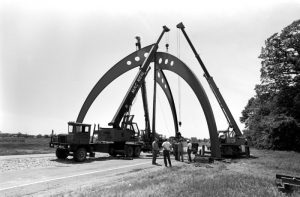Paintbrush
Back in 1972 or so, while I was a graduate student at Cornell University, fellow graduate student Steve Herb joined Fermilab experiment E-26. On one of his regular visits back to Cornell, Steve said that he was called into Fermilab Director Bob Wilson’s office. “What for?” I asked. Apparently Fermilab artist Angela Gonzales was not very happy about the green color that Steve had painted his toroid magnets.
Steve said that he could remove the windings that they had laboriously placed on the steel toroids, repaint and restore the windings. However, that would probably kink the windings, which would require the purchase of new copper cables. So he asked Bob whether he should do that.
Steve said that Bob replied something like, “Oh, it’s OK. But next time, before you pick up a paint brush, check with Angela first.”
Viewpoint
In June 1978, Fermilab Director Bob Wilson’s sculpture “Broken Symmetry” was erected at the Pine Street entrance to Fermilab. I had been away on the day that it was erected, so later that evening my wife Jean and I walked in from our nearby home in Batavia to check it out.
Just as we approached “Broken Symmetry” from the west, Bob Wilson drove in from the east. He asked, “What do you think?” I said, “Pretty interesting … why did you paint it black?” Bob replied, “It’s not black, it’s orange.” Startled, I said “Say what?” Bob replied, “Come over here,” at which point I realized what he had done. I guess you just shouldn’t ask an artist “Why?”.
A paint job
In 1983, as we prepared for the first beam from the Fermilab Tevatron, we refurbished and upgraded all of our facilities in the Fixed Target Experimental Areas. Although the Tevatron was to be capable of running at an energy of 800 GeV, the first few months of operations were to be limited to 400 GeV in order to finish off some experiments that were not to be upgraded to 800-GeV capability. I added a second dipole magnet to the single-dipole magnet in the Proton East primary beamline (my version of the Energy Doubler). In November 1983, a colleague was trying to tune the first Tevatron 400-GeV beam through these two dipoles in Proton East, without luck. The beam somehow got lost in those 40 feet of magnets. I walked into the control room and, using the beam loss monitors, was able to thread the beam through the two dipoles, but at 50 percent greater electrical current than expected. This indicated some sort of electrical short, which meant lower magnetic field and less bending. Since we had designed for 800-GeV operations, this extra current was within our tuning range at 400 GeV, at least for the short term.
During the next interruption of accelerator operations, that typically occur while commissioning a new machine, I accessed the Proton East beamline to see if I could determine what the problem was. Everything looked normal until I noticed that that the beam pipe on the upstream B2 dipole was a little wider (5 inches) than for the downstream B2 dipole (4 inches). “What the…!?!” One of those baby blue (NAL Blue Light) dipole magnets was really a B1 dipole, which should have been dark blue (NAL Blue Dark). The inner coils of the B1 and B2 dipoles are wired exactly opposite, so when the electricians saw the baby blue color, they had hooked up the B1 magnet as if it were a B2 magnet, thereby setting them up so that the two outer coils produced magnetic fields pointing upwards and the one inner coil produced a magnetic field pointing downward. This reduced the net field in that magnet, requiring more current to get the required beam bending. Once this was realized, it was an easy fix to reconfigure the connections for proper operation. With a Sharpie pen, I wrote on that miscolored magnet, “This is really a B1 magnet.” Yes, I should have noticed that error before beam arrived, but that level of subtlety was a little beyond normal.
The next workday, I discussed this with the engineer in charge of the beamline installations who said that earlier, in the shop, they had given a summer student a can of baby blue paint and told him to “paint those magnets,” not realizing that there was a B1 in among the B2s.
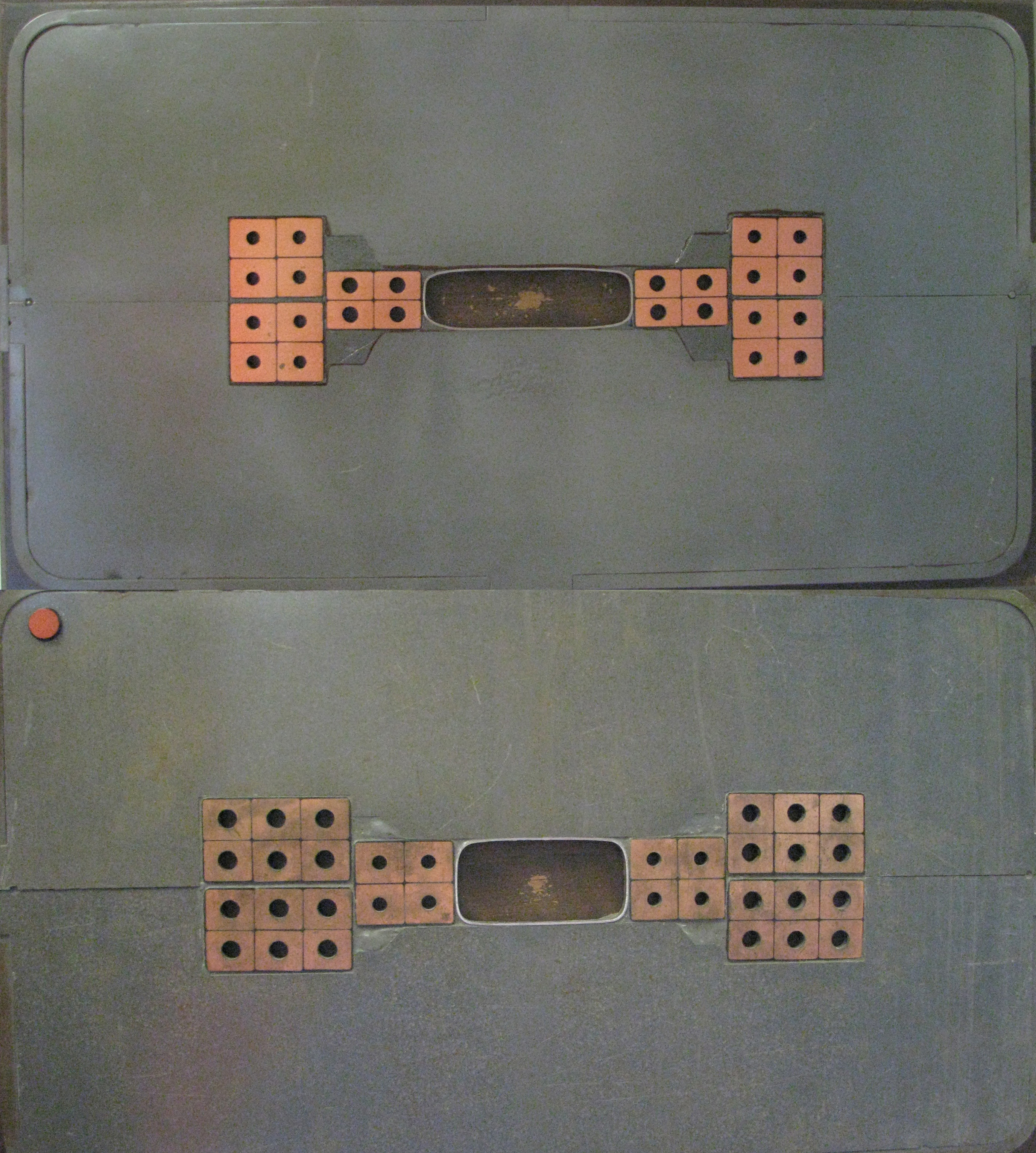
You’d be hard-pressed to tell the difference between these two types of magnets (B1 upper, B2 lower), which were both painted light blue, installed in the beam tunnel simply from the widths of their beam pipes.
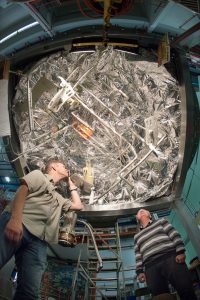
Andy Hocker, left, and Mike Lamm stand beneath a cryostat lid, from which a magnetic section will be suspended. Photo: Reidar Hahn
In July 2015, a key cryogenic facility at Fermilab was shut down, leaving the laboratory’s Mu2e experiment without a space to test its superconducting magnets. Luckily, in the search for new physics at Fermilab, it’s “waste not, want not”: A new cryogenic testing facility for Mu2e now lives in a space occupied by a previous experiment, called CDF, and is even created with refurbished parts from past experiments, including CDF.
The Mu2e experiment aims to capture a hypothesized phenomenon that has never been observed: a particle called a muon converting directly into an electron. If scientists were to witness this rare event, it could signal that there are other, hidden particles in the universe yet to be discovered.
“The idea of Mu2e is rather simple: to detect this reaction,” said Michael Lamm, one of the lead scientists on the Mu2e experiment. “We’re going to measure it to a sensitivity that’s never been reached.”
The Mu2e experiment is specifically designed to achieve this unmatched sensitivity. Comprising three superconducting magnet sections, it stretches nearly the length of a lap pool — about 75 feet.
The experiment’s most distinctive feature is its S-shaped central section, called a transport solenoid, which contains 52 coils of superconducting wire that act as magnets. Manufacturers in Italy will wind each coil and place them into 14 sections, which will be assembled at Fermilab to create the solenoid’s serpentine shape.
But before the solenoid can be put together, each section of the magnet needs to be tested to make sure it works under the ultracold conditions necessary for superconductivity.
“Imagine you build the magnet, transport it into the building and put it in place. And then you turn it on and the magnets don’t work. It would be very risky,” Lamm said.
To eliminate this possibility, the 14 solenoid sections, each containing between two and five coils, will be sent to Mu2e’s new cryogenic testing facility before assembly. The magnet vendor will have already tested the magnets at room temperature to check for electrical issues such as short circuits, but at Fermilab’s cryogenic testing facility, the sections will really be put through their paces.
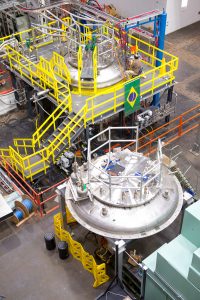
On the upper level, a technician works on the Mu2e cryostat. On the ground level, a separate cryostat lid is being prepared for use. Photo: Reidar Hahn
“Since these magnets are superconductors, they have to be cooled down to liquid-helium temperatures—about 5 Kelvin,” said Andy Hocker, leader of the cryogenic facility. “We’ve put together this facility to make sure they’ll be able to operate as they will in the experiment.”
To reach frigid 5 Kelvin (that’s about minus 451 degrees Fahrenheit, a few degrees warmer than outer space), the magnet sections are suspended in a cryostat, which Hocker called “a glorified thermos.” Inside the cryostat, the magnet is isolated from the warmth of the outside world, allowing the section to be slowly cooled with liquid helium, a process that takes about a week.
And then comes the real test: running an electrical current through the coils that’s 20 percent higher than the one that will be used once Mu2e is online.
“You want to make sure these magnets can go up to well beyond the current they’ll need to operate at during the experiment and still stay nice and cold to keep them from transitioning to a normal conductor,” Hocker said.
Each solenoid section will take four to six weeks to test, including the gradual cooling and an equally slow warming period. The first section will arrive this fall, beginning a nearly two-year testing process that should be complete by 2019.
Once the transport solenoid has been tested, constructed and joined with two other sections to make up the Mu2e detector, the experiment will begin a three-year run in search of physics beyond the Standard Model.
“If we see this interaction here, this would be new physics. It would really just knock your socks off,” Lamm said. “If we don’t see it, we’ll be able to rule out some of the current theories predicting new physics beyond the Standard Model. Either way, we’ll find out the truth from nature.”
I used to feed the bison back in the day. We used to have two herds. One was where the current herd lives now, and the other was across the street. For that second herd, there were no trees or anything, so when the bison would shed their winter fur, they would rub against the fence posts to get the old fur off. They could actually destroy a fence. So a co-worker and I had to put up a scratch post, a big post with a big steel cable.
When we started setting up this post, the bison were way in the corner of the field. We’re sitting there working, and all of the sudden we heard this grunt. We look and the bull’s right there. Other bison are surrounding us. And I said to the other guy, “Let’s go.” He said, “Oh, they’re not going to mess with you.” I said, “I know, because I’m leaving. If you want to go, we can go.”
He didn’t want to go, so I got in the truck and left. They didn’t mess with him.
I’d seen how young bulls behaved before. Once a guy had left a tractor idling as we were going to lunch. The young bull was disturbed by it, and he kept charging it, and he finally hit it. He popped that tractor tire like it was a balloon. He almost knocked it over.
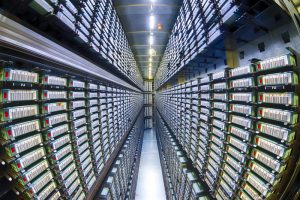
At Fermilab, tape libraries house data from particle physics and astrophysics experiments. Photo: Reidar Hahn
VHS may have vanished, and cassettes are no longer cool, but tape is still on top when it comes to particle physics data: Fermilab stores over 100 petabytes of data, equivalent to 1,300 years of HD TV, on tape cartridges.
But why is tape, which is generally considered obsolete for music or movies, the go-to for storing all this data?
“Tape is the safest medium you can have,” said Stu Fuess, a senior scientist working in computing at Fermilab. “With tape, a machine can’t crash and cause you to lose your data.”
Fermilab’s seven tape libraries — three at the laboratory’s Feynman Computing Center and four at its Grid Computing Center — have the capacity to hold 10,000 tapes each, adding up to 600 petabytes of data storage. That leaves a lot of storage capacity that isn’t in use — yet.
“One challenge of data storage is that we don’t ever really want to throw data away — sometimes experimenters will reanalyze data years later to find something they never thought to look for,” Fuess said.
And now, increasingly large amounts of data are accumulated from more complex particle detectors, causing a growth in data Fuess called “almost exponential.”
Fermilab’s expedition into the intensity frontier — the realm of physics that requires highly intense particle beams to search for new physics — requires detailed detectors and a lot of data, enough to say whether an observation is a fundamental particle or a fluke.
“Particle physics is a statistical science, especially the intensity frontier,” Fuess said. “The more data you can accumulate, the more statistical power you can add to your measurements.”
In addition to 40 petabytes of data from intensity frontier experiments such as Fermilab’s neutrino experiments MicroBooNE and NOvA, the lab stores 40 petabytes of data from the CMS detector at the Large Hadron Collider in Switzerland. The legacy Tevatron experiments, CDF and DZero, each contribute another 10 petabytes. That brings the total to 100 PB of active data storage on tapes. A few extra petabytes of data from the Dark Energy Survey is housed in the Fermilab tape repositories, too, along with an unlikely data-neighbor: genomic research from the Simons Foundation Autism Research Initiative.
One of tape’s biggest drawbacks is speed, even though tape libraries are fully automated and manned by robotic retrieval arms.
“When you want to access a file, you have to find a free tape drive — the robot’s got to find the tape and put it in the tape drive,” said Gene Oleynik, a computing services manager in charge of data movement and storage at Fermilab. “All this communication has to happen to access data, and this happens in an order of minutes,” which, when compared to the fractions of a second it takes to retrieve digital data, is pretty slow going.
To speed up this process for high-demand files, about 35 petabytes of data from tapes has a copy that lives on disks, which offer much faster, although not instantaneous, file access. Disks don’t have to be physically retrieved and put in a drive by robots, and they can be read nonsequentially, with more efficiency than a tape.
Eventually disk systems may overtake tape if they become a cheaper data storage option, but disks can be unreliable.
“Tapes usually don’t fail. You should be able to keep a tape for 30 years and it’ll retain the data. But the problem with disks is, they do fail,” Oleynik said.
A disk system would have to store redundant pieces of files across many different disks to prevent data loss, but duplicating data means more data to store, also making the system less cost effective.
In the case of storing particle physics data, disks probably can’t make tapes obsolete; even in a disk system, there will probably be tapes as backup, just in case. Until a cost-effective data storage medium arrives that can match the reliability of tapes, it looks like they’re sticking around.




